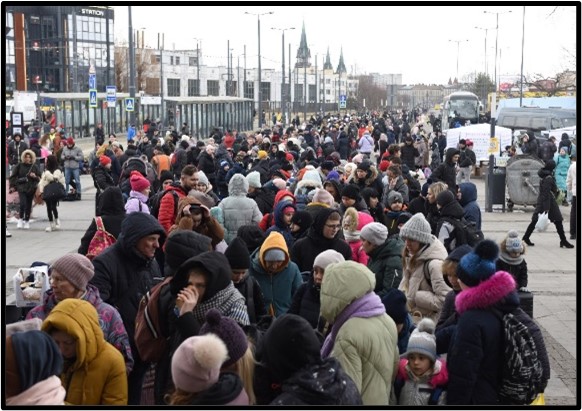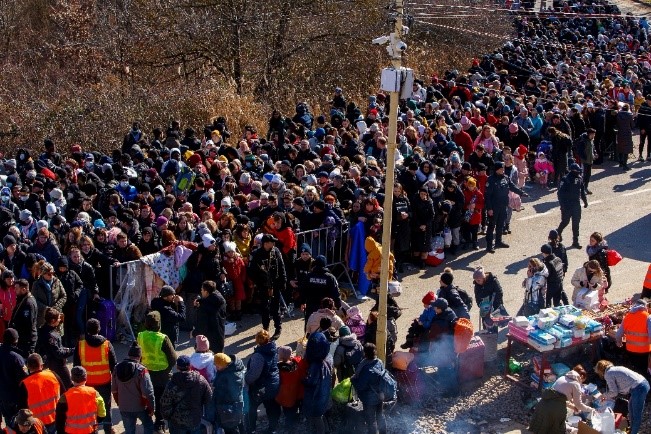Russia’s invasion of Ukraine:
The treatment of non-Ukrainian refugees
By Hung Le and Anna Diagne Sene
Russia’s invasion of Ukraine in February 2022 triggered Europe’s worst refugee crisis since World War II. The UN estimates that more than 9.6 million Ukrainian and non-Ukrainian refugees have fled the country, primarily to destinations in Hungary, Poland, Romania, Slovakia, or Germany.[1]
The International Organization for Migration reported that 450,000 third-country nationals (TCNs), meaning non-Ukrainians, lived in Ukraine before the war.
This figure included 300,000 permanent residents and 150,000 temporary residents.[2]
Over 76,000 temporary residents are foreign students, primarily from India (24%), Morocco (12%), Turkmenistan (7%), Azerbaijan and Nigeria (6% each).[3]
Following the invasion, over 275,000 TCNs’ from Ukraine sought refuge in European Union (EU) countries. Information about the other half of the TCN population is scarce.
Many foreigners who fled from Ukraine reported discriminatory treatment at border crossings and in the new host countries. Several African students reported that they were forced off buses and trains heading to Ukraine’s borders, apparently because they were black. Lacking alternatives, they walked significant distances to border crossings in freezing temperatures.[4] At border checkpoints, guards often prioritized Ukrainians and sent non-Ukrainians to the back of queues that sometimes stretched for miles.[5]The Independent reported that Polish border police arrested 52 TCNs who were fleeing from Ukraine, including several African students who were then held in detention centers during the first weeks of the war.[6]
Non-Ukrainians who fled to EU countries have been trapped in a legal limbo. In March, the EU activated the Temporary Protection Directive, granting refugees from Ukraine the right to reside and work in the EU for up to three years.[7]
However, several EU countries have excluded TCNs and stateless persons from this scheme.[8] Non-Ukrainians without permanent residency must go through the lengthy application process for asylum or visas to stay in these countries.
Although several foreign governments, including China, India, Pakistan, and Nigeria, have repatriated their citizens, not all foreign nationals fleeing from the war want to return home.[9] Up to 10,000 African students seek to finish their education in the EU.[10] Many have spent their families’ life savings or borrowed heavily to study in Ukraine and will lose everything if they return without a degree. While scores of European universities have offered generous scholarships to Ukrainians, African students are left to fend for themselves or rely on charities for support. Most of these students have only a few months to secure spots at European universities and to find tuition money or face deportation.[11]
TCNs are not the only ones to face discrimination en route to safety. The invasion has exacerbated the already difficult situation of Ukraine’s 400,000 Roma people, one of the most marginalized communities throughout Europe, and forced as many as 100,000 to become refugees.[12] Reports have surfaced of violence targeting Roma in Western Ukraine[13] and of Roma families turned away at border crossings.[14] In Hungary and Moldova, Roma refugees face additional hardships, such as a lack of identification documents (around 10 to 20% of Ukraine’s Romani people are stateless[15]), separation from family members, language barriers, and long-established patterns of discrimination and harassment.[16]
The disparate treatment of Ukrainian and non-Ukrainian refugees raises concerns about the extent to which race, ethnicity, religion, and nationality influence the West’s humanitarian responses. Portrayals of Ukrainian refugees as “white,” “Christian,” and “European”[17] by some Western media and politicians obscure the reality that many refugees from Ukraine are, in fact, non-white, non-Christian, non-European, and equally deserving of protection.
On the other hand, Europe’s exceptional solidarity with Ukrainians can be attributed to geographical and language proximity to Ukraine and to a shared history of Russian aggression and occupation. Furthermore, the massive scale of the crisis has intensified the pressure on the EU’s already overburdened refugee resettlement system, forcing several countries to adjust their asylum policy to prioritize refugees from Ukraine.[18]
Despite the EU’s stated goal to support everyone fleeing the war, many non-Ukrainian and stateless refugees clearly face additional barriers. Several advocacy groups and human rights organizations are assisting non-Ukrainian and Roma arrivals and promoting awareness about their unique situations. Ultimately, it is hoped that the EU will resolve the inequities in this latest refugee crisis.
August 4, 2022
Images
Lviv train station:
https://depositphotos.com/551345404/free-stock-photo-lviv-ukraine-march-2022-refugees.html
— Photo by Bumble-Dee
Ukraine-Slovakia border:
https://depositphotos.com/550433082/free-stock-photo-uzhhorod-ukraine-february-2022-people.html
— Photo by Ukrinform
Sources
[1] https://reporting.unhcr.org/ukraine-situation#_ga=2.127758094.2046621094.1654606304-111879885.1654166841
[2]https://www.iom.int/search?keywords=Ukraine%20Response%202022&type%5B0%5D=situation_report®ion_country=ukraine&created=All
[3] https://studyinukraine.gov.ua/en/
[4] https://www.youtube.com/watch?v=95ABSqRpy74&ab_channel=BBCNewsAfrica
[5] https://www.dw.com/en/africans-fleeing-ukraine-accuse-germany-of-double-standards/a-61879479
[6] https://www.independent.co.uk/news/world/europe/ukraine-refugees-detention-international-students-b2041310.html
[7] https://www.fragomen.com/insights/european-unionukraine-eu-member-states-start-implementing-temporary-protection-directive.html
[8] Ibid.
ttps://www.janes.com/defence-news/news-detail/ukraine-conflict-monitoring-evacuation-of-foreign-nationals-from-ukraine
[10] https://news.trust.org/item/20220415085154-wtadr/
[11] https://www.aljazeera.com/news/2022/5/13/african-students-who-fled-war-in-ukraine-fight-to-keep-studying
[12] https://www.ecmi.de/infochannel/detail/ecmi-minorities-blogthe-response-of-international-organisations-and-roma-civil-society-to-the-plight-of-ukraines-roma-refugees-in-europe#:~:text=According%20to%20available%20estimates%2C%20the,ongoing%20active%20phase%20of%20hostilities.
[13] https://jacobin.com/2022/04/russian-war-invasion-ukraine-roma-romani-violence
[14] http://www.errc.org/news/romani-family-denied-exit-from-ukraine-border-guards-accuse-roma-of-wrongdoings-in-hungary; https://www.aljazeera.com/news/2022/3/7/ukraines-roma-refugees-recount-discrimination-on-route-to-safety?fbclid=IwAR0Frfi5uJOj-ghH2PaNTHHQObAdCYQa75Jq526JfpFNAtyS_WS2FHTq2tU
[15] https://www.statelessness.eu/sites/default/files/2022-03/ENS%20Briefing%20-%20Stateless%20people%20displaced%20from%20Ukraine%20-%20March%202022_1.pdf
[16] https://www.npr.org/2022/05/21/1098489307/roma-refugees-moldova-ukraine-war
[17] https://www.independent.co.uk/news/world/europe/ukraine-refugees-response-europe-racist-b2024840.html
[18] https://www.infomigrants.net/en/post/42018/ireland-visa-requirement-for-refugees-changes




